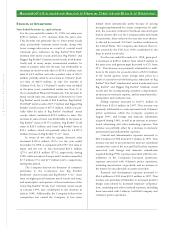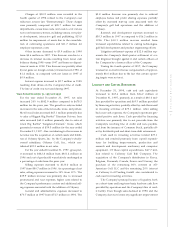Callaway 1998 Annual Report Download - page 20
Download and view the complete annual report
Please find page 20 of the 1998 Callaway annual report below. You can navigate through the pages in the report by either clicking on the pages listed below, or by using the keyword search tool below to find specific information within the annual report.
CALLAWAY GOLF COMPANY
18
in either their local currencies or the euro, the official
currency of EMU participating Member States. Parties
are free to choose the unit they prefer in contractual rela-
tionships during the transitional period, beginning
January 1999 and ending June 2002. The Company has
installed a new computer system that supports sales
throughout Europe. This new system runs substantially
all of the principal data processing and financial report-
ing software for such sales. The Company anticipates
that, after the implementation of an upgrade, the new
system will contain the functionality to process transac-
tions in either a country’s local currency or euro. The
implementation of this upgrade, which is part of a larg-
er plan to update the Company’s enterprise-wide soft-
ware to the manufacturer’s current version, is planned to
take place during 2000. Until such time as the upgrade
has occurred, transactions denominated in euro will be
processed manually. The Company does not anticipate a
large demand from its customers to transact in euros.
Additionally, the Company does not believe that it will
incur material costs specifically associated with manual-
ly processing data or preparing its business systems to
operate in either the transitional period or beyond.
However, there can be no assurance that the conversion
of EMU Member States to euro will not have a materi-
al adverse effect on the Company and its operations.
Market Risk
The Company is exposed to the impact of foreign cur-
rency fluctuations due to its international operations
and certain export sales. The Company is exposed to
both transactional currency/functional currency and
functional currency/reporting currency exchange rate
risks. In the normal course of business, the Company
employs established policies and procedures to manage
its exposure to fluctuations in the value of foreign cur-
rencies. During 1998, the Company entered into for-
ward foreign currency exchange rate contracts to hedge
payments due on intercompany transactions by one of
its wholly-owned foreign subsidiaries, Callaway Golf
Europe Ltd. The effect of this practice is to minimize
variability in the Company’s operating results arising
from foreign exchange rate movements. These foreign
exchange contracts generally do not subject the
Company to risk due to exchange rate movements
because gains and losses on these contracts offset losses
and gains on the intercompany transactions being
hedged, and the Company does not engage in hedging
contracts which exceed the amounts of the intercompa-
ny transactions.
However, pursuant to its new foreign exchange
hedging policy, beginning in January 1999, the
Company also may use forward foreign currency
exchange rate contracts to hedge certain firm commit-
ments and the related receivables and payables with
other foreign subsidiaries. Additionally, the Company
expects that it also may hedge anticipated transactions
denominated in foreign currencies using forward foreign
currency exchange rate contracts and put or call options,
which may be combined to form range forwards.
Foreign currency derivatives will be used only to the
extent considered necessary to meet the Company’s
objectives and the Company does not enter into forward
contracts for speculative purposes. The Company’s for-
eign currency exposures include most European curren-
cies, Japanese yen, Canadian dollar and Korean won.
Additionally, the Company is exposed to interest
rate risk from its Credit Facilities (see Notes 4 and 16 to
the Company’s Consolidated Financial Statements)
which are indexed to the London Interbank Offering
Rate (“LIBOR”).
Sensitivity analysis is the measurement of potential
loss in future earnings of market sensitive instruments
resulting from one or more selected hypothetical
changes in interest rates or foreign currency values. The
Company used a sensitivity analysis model to quantify
the estimated potential effect of unfavorable movements
of 10% in foreign currencies to which the Company was
exposed at December 31, 1998 under its derivative
financial instruments.
The sensitivity analysis model is a risk analysis tool
and does not purport to represent actual losses in earn-
ings that will be incurred by the Company, nor does it
consider the potential effect of favorable changes in mar-
ket rates. It also does not represent the maximum possi-
ble loss that may occur. Actual future gains and losses
will differ from those estimated because of changes or
differences in market rates and interrelationships, hedg-
ing instruments and hedge percentages, timing and
other factors.
The estimated maximum one-day loss in earnings
from the Company’s foreign-currency derivative finan-
cial instruments, calculated using the sensitivity analysis
model described above, is $1.2 million at December 31,
1998. The Company believes that such a hypothetical
loss from its derivatives would be offset by increases in
the value of the underlying transactions being hedged.
Notes 2 and 4 to the Consolidated Financial
Statements outline the principal amounts, weighted-
average interest rates, fair values and other terms
required to evaluate the expected cash flows and sensi-
tivity to interest rate changes.
























